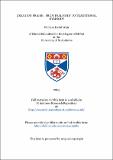Files in this item
Creation praise : from psalmody to traditional hymnody
Item metadata
| dc.contributor.advisor | Bradley, Ian C. | |
| dc.contributor.author | Watt, William David | |
| dc.coverage.spatial | vi, 125 p. | en_US |
| dc.date.accessioned | 2018-05-29T12:42:11Z | |
| dc.date.available | 2018-05-29T12:42:11Z | |
| dc.date.issued | 2005 | |
| dc.identifier.uri | https://hdl.handle.net/10023/13589 | |
| dc.description.abstract | This thesis examines the types of creation imagery used in the Psalms, looking at the historical and cultural influences that affected the Old Testament concepts encapsulated in this Psalmody, and at how traditional creation hymnody has incorporated and modified these concepts. The first chapter examines creation psalmody and argues that there is an overall inclusiveness to be found in such Psalms, where God is viewed as working through the whole of creation and that such Psalms are generally less anthropocentric than some other Biblical texts. This immanent approach is particularly evident through the Old Testament concept of Creator Spirit. Creation hymns are discussed in the three chapters that follow, focusing firstly on hymns of seed-time and harvest, secondly on hymns of the Holy Spirit, and thirdly on hymns with a christological perspective that deal with the main Christian Festivals around Christmas and Easter. In examining rogation-tide hymns and May Day carols, the seedtime and harvest chapter finds many similarities to the images used in creation psalmody, as well as imagery from the old traditional May Day festivals which pre-date Christianity in Britain but which contain a similar kind of natural spirituality to the Old Testament concepts of Creator Spirit. The Harvest Festival hymns, on the other hand, tend to take a more anthropocentric approach, but nevertheless do contain some of the immanent approaches from the Old Testament, in particular the Hebrew Harvest Festival. Chapter 3 examines hymns of the Holy Spirit, and I argue that it is in these hymns that we can find a more fully developed immanent type of theology. Chapter 4 looks at the christological perspectives to the natural world to be found in traditional hymnody, examining in more detail the areas of transcendence and immanence and the implications of the inevitable anthropocentric viewpoint to be found in these texts. I argue in this chapter that it is possible to take a wider and more contemporary theological interpretation of this type of hymnody, and that by doing this we find these hymns amenable to a more inclusive approach to creation as a whole. The thesis concludes by considering the implications of this analysis for worship in the twenty first century. | en_US |
| dc.language.iso | en | en_US |
| dc.publisher | University of St Andrews | |
| dc.subject.lcc | BV310.W2 | |
| dc.subject.lcsh | Hymns--History and criticism | en |
| dc.subject.lcsh | Psalmody | en |
| dc.subject.lcsh | Bible.--O. T.--Psalms--Criticism, interpretation, etc. | en |
| dc.subject.lcsh | Creation--Biblical teaching | en |
| dc.subject.lcsh | Creation in literature | en |
| dc.title | Creation praise : from psalmody to traditional hymnody | en_US |
| dc.type | Thesis | en_US |
| dc.type.qualificationlevel | Doctoral | en_US |
| dc.type.qualificationname | MPhil Master of Philosophy | en |
| dc.publisher.institution | The University of St Andrews | en_US |
This item appears in the following Collection(s)
Items in the St Andrews Research Repository are protected by copyright, with all rights reserved, unless otherwise indicated.

